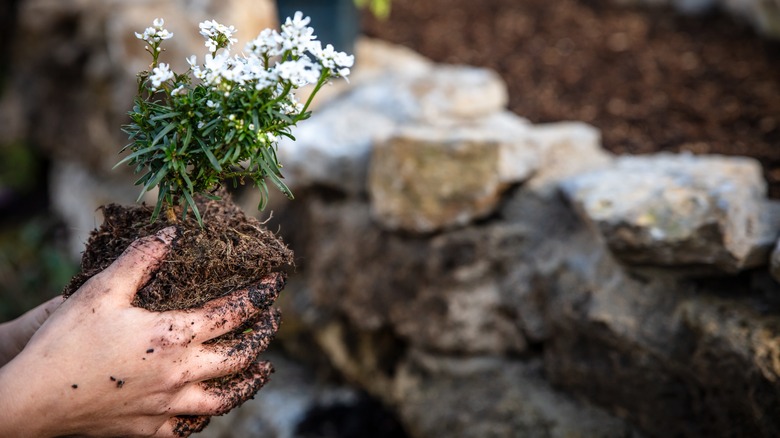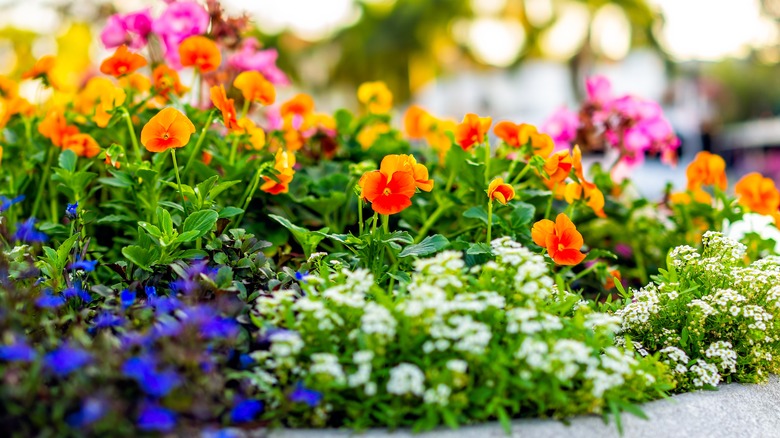The Difference Between Sweet Alyssum & Candytuft (& Which Is Best To Grow)
You just had a dream of the ideal low-height ground cover plant. It was perennial, evergreen, and covered in pretty little white flowers that bloomed more than once during the growing season. It needed little care and maintenance. It even self-seeded, but without making a nuisance of itself and going all over the yard. It sounds a little like sweet alyssum, but your ideal bloomer wasn't the plant that garden centers everywhere seem to push.
Sweet alyssum (Lobularia maritima) will offer its appealing little flowers throughout the lazy, hazy days of summer (and even longer in coastal California, where it harkens back to its Mediterranean roots and behaves like an evergreen perennial), but it isn't like the plant in your dream, partially because unless it's in a warm climate, it's an annual. The dream plant is candytuft (Iberis sempervirens). It checks every box on your dream list, but first you have to make sure you can tell the difference between sweet alyssum and candytuft.
What are the differences between the easy-to-find sweet alyssum and the nearly ideal ground cover candytuft? For starters, they aren't in the same plant taxonomy. In the scientific classification, Lobularia and Iberis both are from the Brassicaceae family, which includes mustards and cabbages, but they're different genera. At 6 to 12 inches, candytuft has a taller profile than 3-inch alyssum, which works better when it tumbles over rocks. Candytuft also grows in more zones (3-8 rather than 5-9). All in all, which is ideal for you?
Satisfy your sweet tooth: Candytuft is one sweet ground cover
There is something about tiny little flowers that are synonymous with the word "sweet." And while sweet alyssum with its tiny flowers is more well-known than candytuft (and has a name that capitalizes on that description), in many ways candytuft is a sweeter addition to just about any landscape plan. The people who maintain Mount Vernon, the historic home of America's first president George Washington, note that because candytuft's flowers pop out simultaneous with many seasonal flower bulbs, the perennial creates a pleasing accent to the short-lived blooms. It's no surprise it made the list of 15 flowering perennials to plant for a stunning spring.
For gardeners sensitive to the need to minimize water usage, candytuft helps you feel good about that, since candytuft is a drought-tolerant plant. If those characteristics aren't sweet enough, deer and rabbits don't seem to want to munch on it, though you may need to keep an eye out for smaller diners like caterpillars and slugs who may want to use your candytuft for their dessert.
Are these features any different, though, from sweet alyssum, which is easier to find? While candytuft might have an edge because it's a perennial, sweet alyssum might be better for some gardens because it doesn't appear to attract pests. It is also one of the colorful flowers that will bring bees into your yard.
Add a little sugar: Plant a buffet of flowers that works best for you
For all the reasons described so far, candytuft (Iberis sempervirens) has what it takes to make your landscape look sweet and dreamy, but you don't need to stop there. It plays nicely with many other plants, including the sweet alyssum it has been mistaken for. Although candytuft is most commonly found in white, if grown from seed, the early blooming flower can be found in other shades like pink. Likewise, sweet alyssum is readily available in white, but savvy shoppers can find it in hues of purple, pink, and, in some nurseries, you might even find shades of red, yellow, and apricot.
Candytuft is drought-tolerant, which makes it a favorable option for more water-greedy companions or for locations like the rock gardens where it is frequently found. Even more helpful is that candytuft can be helpful in many locales because it is salt-tolerant. Normally, a gardener's first thought upon hearing that a plant tolerates salty conditions is that it would work well near the seashore, which it would, but it also means that candytuft is a good option to place around flower beds that might get exposed to winter rock salt used to melt snow and ice from roads, making the perennial a very special sweet and salty addition to your garden.


